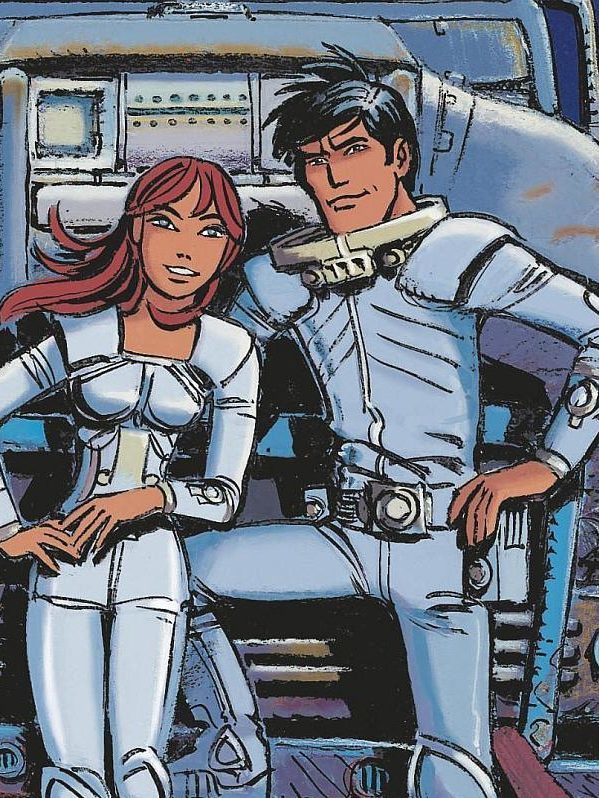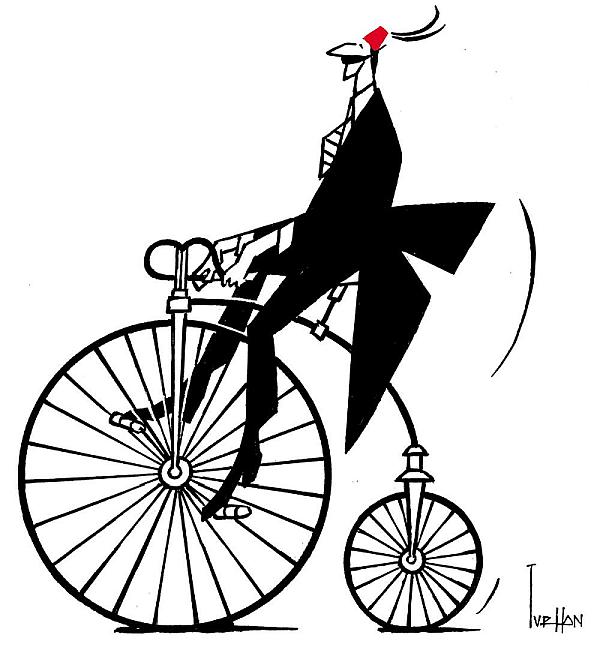The diversity of European comics makes their classification quite complex, and offers up characters of all stripes to readers in each country. In this article, we take a look back at the continent’s comics heritage, highlighting some of the most popular comics characters from all over Europe, from Spain to Turkey. Thanks to our publishing partners for their contributions to this list: Ballon in Belgium, BAO and Tunué in Italy, Timof in Poland, Darkwood in Serbia, Dibbuks in Spain, and Akan Ajans in Turkey.
BELGIUM
Flanders (Dutch-speaking Belgium)
Suske and Wiske (Willy and Wanda), by Willy Vandersteen
Started in 1945 in a magazine, this series is still published today and narrates the adventures of two children along with their family and friends, combining all kinds of genres from comedy to science fiction.
De Kiekeboes, by Merho
Started in 1977, De Kiekeboes is very popular in Flanders. The main characters are the Kiekeboe family, with the parents, Marcel and Charlotte, as well as their children, Fanny and Konstantinople.
Wallonia (French-speaking Belgium)
Tintin, by Hergé
Tintin was created in 1926 and hasn’t aged a day. With his easily identifiable quiff, he was meant to be a flawless hero, with high moral standards and great integrity. He is a reporter but acts as a detective seeking truth and justice, with his loyal dog Snowy.
.
Les Schtroumpfs (The Smurfs), by Peyo
The Smurfs are small blue human-like creatures who “smurf” a lot of things. They live in mushroom-like houses where each smurf is named after their personality or their role in the village. Papa Smurf is their leader, and their ranks include Smurfette (the first female smurf), Poet Smurf, Vanity Smurf, and Lazy Smurf, to name but a few.
Lucky Luke, by Morris
From the eponymous western series created in 1946, Lucky Luke is the man “who shoots faster than his shadow.” On his horse Jolly Jumper and accompanied by Rantanplan, a prison guard dog, he travels across the West and beyond to maintain law and order, in a seemingly endless series of hilarious adventures.
BULGARIA
Hitar Peter (Sly Peter), by Venelin Varbanov
Hitar Petar is a character of Bulgarian and Macedonian folklore, adapted for comics by Venelin Varbanov after the fall of communism.
.
.
Choko and Boko, by Rumen Petkov
Choko and Boko, from Choko the Stork and Boko the Frog, were published in the magazine Duga (Rainbow) in Bulgaria, during the Cold War. Choko is a naïve stork who is always trying to prove himself by trying out various professions… in which he utterly fails. Boko is a frog whose incompetence often leads to explosions.
Darko, by Nikolai Dudov
With his magic red-and-white hat, the stupid boy Darko, created by Nikolai Dudov, is perhaps the most recognizable character of the magazine Duga.
FRANCE
Asterix & Obelix, by René Goscinny and Albert Uderzo
The main characters of The Adventures of Asterix, Asterix is the hero of the village and is aided by Obelix, his corpulent but robust friend, who gained super strength after falling into a magic potion when he was a baby. With this potion, they are able to defend their village against the Roman Empire and go on various adventures.
Valerian & Laureline, by Pierre Christin and Jean-Claude Mézières
Created in 1967, Valerian & Laureline narrates the adventures of an unforgettable pair of spatio-temporal agents. Valerian began as the typical handsome hero, strong and upstanding, but gradually gained greater complexity as the series progressed.
.
Marji (Persepolis), by Marjane Satrapi
Marji is the main character in Persepolis, an autobiography about the childhood of Marjane Satrapi in Iran in the 1980s, during and after the Islamic Revolution. Published in 2000, this graphic novel was translated in many languages and adapted for film in 2007, winning several awards along the way.
GERMANY
Dig, Dag und Digedags (Dig, Dag and Digedags), by Hannes Hegen
Dig, Dag, and Digedags are the heroes of The Digedags, published in the German Democratic Republic comics magazine MOSAIK, from 1955 to 1975. Equally humorous and hot-tempered, they travel through time and space, having incredible adventures.
Vater und Sohn (Father and Son), by O.E. Plauen
Featuring the everyday adventures of a father and his son, this silent comic is one of the only illustrated stories published during the Third Reich that has remained in the memory of German readers.
Max und Moritz (Max and Moritz), by Wilhelm Busch
Created in 1865, this series marked by its black humor was first meant for an adult audience, before the terrible duo became famous children’s book characters, still appreciated today by readers of all ages.
ITALY
Asso di Picche, by Mario Faustinelli, Alberto Ongaro and Hugo Pratt
Created in 1945, Asso di Picche (Ace of Spades) is a masked crime fighter who combats an international crime syndicate called the Band of Panthers in this classic comics series.
.
Corto Maltese, by Hugo Pratt
Corto Maltese is a modern anti-hero, a sailor, and a “man of fortune.” He is driven by the rush of new experiences, always ready to fight to affirm the principles of liberty and independence, and he is seen by some as an ideal travel companion.
Tex Willer, by Gian Luigi Bonelli and Aurelio Galleppini
Tex Willer, main character of Tex, is described as a tough guy with a strong personal sense of justice, who becomes a ranger and defends honest folks against villains of all kinds. First published in 1948, this series is inspired by Westerns of the era.
NETHERLANDS
Bulletje en Boonestaak (Bully and Beanstalk), by A.M. de Jong and George van Raemdonck
Created in 1922 for the Dutch socialist newspaper Voorwaarts, it was the first Dutch comic to break through on a wide scale, and recounts the adventures of two boys who accompany their fathers on a long trip to sea. The series caused controversy for its often mature content.
.
De Generaal (The General), by Peter de Smet
De Generaal is the best representation of De Smet’s fascination with military stupidity. Published fom 1971 to 1997, the main character is a general desperate to seize power, who continuously tries to force a rival marshal out of his fortress.
Fokke & Sukke (Duck & Birdie), by John Reid, Bastiaan Geleijnse and Jean-Marc Van Tol
Fokke & Sukke are a duck (wearing a small sailor’s cap) and a canary (wearing a backward baseball cap) who give their politically incorrect vision and opinion on just about everything, in a one-panel comic. Very popular in Netherlands, it was also published in Germany and English-speaking countries starting in the 2000s.
POLAND
Kapitan Żbik (Captain Zbik)
Captain Zbik is a Polish comics series published from 1967 to 1982, produced by dozens of authors over the years. The eponymous hero, Jan Żbik, is a captain of the Milicja Obywatelska, the national police organization of the Polish People’s Republic. The series includes more than 50 volumes and spinoffs.
.
Kajko i Kokosc (Kayko and Kokosh), by Janusz Christa
This classic Polish comic series by Janusz Christa is about two famous medieval Slavic warriors: the brave Kajko and the selfish Kokosz, who defend their village Mirmiłow from various villains. The series includes more than 20 volumes plus a number of spinoffs.
Tytus, Romek i A’Tomek (Tytus, Romek and A’Tomek), by Henryk Jerzy Chmielewski, aka Papcio Chmiel
Tytus, Romek and A’Tomek is one of the most popular Polish comics series, created in 1957 and still published today. It focuses on the adventures of Romek and A’Tomek, two Boy Scouts, and Tytus de Zoo, a talking chimpanzee. There are 42 volumes in the series, with the last published in 2018. The 96-year-old author hasn’t put down his pen yet.
PORTUGAL
Jim Del Monaco, by António José Simões and Luís Louro
Started in 1985 and first published in periodicals, Jim del Monaco is a parody of Alex Raymond’s Jungle Jim, and one of the rare successes of the decade in the world of Portuguese comics.
.
As Aventuras de Dog Mendonça e Pizzaboy (The Adventures of Dog Mendonça & Pizzaboy), by Filipe Melo and Juan Cavia
Dog Mendonça is a private detective (and werewolf), who goes on countless adventures alongside Pizzaboy, a pizza delivery guy; a gargoyle; and a 6,000-year-old demon, facing off against demons, Nazis, and the Apocalypse.
SERBIA
Zigomar, by Nikola Navojev and Branko Vidić
A hero without superpowers from the 1930s, the Golden Age of Serbian comics, Zigomar fought crime wherever he encountered it. He first appeared in the magazine Mickey’s Kingdom, and is often assisted by his Chinese companion Chi Yang.
Mirko and Slavko, by Desimir Žižović
This Yugoslav comics series, very famous in the 1960s, tells the story of two Yugoslav Partisan couriers, Mirko and Slavko. It was the first and only Yugoslav comic to be adapted into a live action movie.
.
Dikan, by Lazo Sredanović
Dikan, one of the most popular Yogoslav comics series in the 1970s, follows the adventures of Dikan and his uncle Vukoje as they travel the Balkans during the 6th century.
SPAIN
Mortadelo y Filemón (Mort & Phil), by Francisco Ibáñez
Mortadelo and Filemón were a duo of private detectives before becoming secret agents in the T.I.A. Created in 1958, this series remains one of the most popular Spanish comics, published in more than a dozen countries and adapted for film multiple times.
Superlópez, by Jan
Superlópez is the Spanish parody of Superman, created in 1973 and still published today. He comes from the planet Chíton, grew up in Barcelona, is an office worker, and has a girlfriend named Luisa Lane. The series was adapted for film in 2018.
.
Capitán Trueno, by Victor Mora and Miguel Ambrosio Zaragoza
Literally meaning Captain Thunder, this hero is a 12th-century knight who travels the world with his companions. First published in 1956, Capitán Trueno is arguably the most popular Spanish comics hero of all time. The series was adapted for film in 2011.
SWEDEN
91:an Karlsson, by Rudolph Petersson
The main character of this series is Mandel Karlsson, a young man completing his national service in the Swedish Army, enlisted as “91:an Karlsson.” The story and other characters are based on the author’s personal experience. Still published today, it has been adapted for film many times.
Rocky, by Martin Kellerman
This series is based on the author’s own life, after being dumped by his girlfriend and fired from his job. It narrates the everyday life in Stockholm of Rocky, an anthropomorphic dog, filled with friends, humor, and hip-hop culture.
e
Bamse: Värladens starkaste björn (Bamse, the World’s Strongest Bear), by Rune Andréasson
Created in 1966, this character is the most well-known in Sweden. Bamse is a brown bear who became the world’s strongest bear by eating his grandma’s dunderhonung (“thunder-honey”). In the 1980s, he got married and had kids, shifting the series from an educational focus to more family-based themes.
TURKEY
En Kahraman Rıdvan, by Bulent Arabacıoğlu
Cuckooreekhoouuugh! That’s the battle cry of Rıdvan, a clumsy and simpleton Istanbul resident with no super powers whatsoever. Created by Bulent Arabacıoğlu in 1980, En Kahraman Ridvan is a social and political satire of the turbulent state of the country during that era.
Avanak Avni (Avni the Gullible), by Oguz Aral
Created in 1973 by Oguz Aral within the pages of the Turkish humor magazine Gırgır, Avni seems to be just a kid from the ghetto. But when he comes across tyrants and bullies in his neighborhood, he always finds a way to stand up for himself. Although that isn’t always easy for an inarticulate kid like Avni, whose vocabulary mostly consists of “duggle duggle” and “mhughu.”
Abdülcanbaz, by Turhan Selçuk
Abdülcanbaz started out his adventures as a scamming tour guide in 1957 Istanbul, but soon went on to overstep boundaries of time and space. His fez, mustache, and womanizing nature are unchanging, wherever action finds him. With this series, Turhan Selçuk set a high bar for Turkish comics that still hasn’t been surpassed, 60 years later.



























